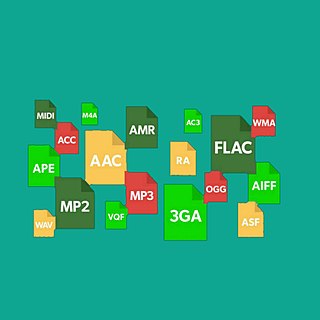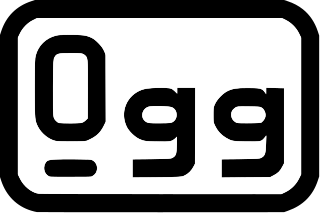
An audio file format is a file format for storing digital audio data on a computer system. The bit layout of the audio data is called the audio coding format and can be uncompressed, or compressed to reduce the file size, often using lossy compression. The data can be a raw bitstream in an audio coding format, but it is usually embedded in a container format or an audio data format with defined storage layer.

Ogg is a free, open container format maintained by the Xiph.Org Foundation. The authors of the Ogg format state that it is unrestricted by software patents and is designed to provide for efficient streaming and manipulation of high-quality digital multimedia. Its name is derived from "ogging", jargon from the computer game Netrek.

Vorbis is a free and open-source software project headed by the Xiph.Org Foundation. The project produces an audio coding format and software reference encoder/decoder (codec) for lossy audio compression, libvorbis. Vorbis is most commonly used in conjunction with the Ogg container format and it is therefore often referred to as Ogg Vorbis.

FLAC is an audio coding format for lossless compression of digital audio, developed by the Xiph.Org Foundation, and is also the name of the free software project producing the FLAC tools, the reference software package that includes a codec implementation. Digital audio compressed by FLAC's algorithm can typically be reduced to between 50 and 70 percent of its original size and decompresses to an identical copy of the original audio data.
Theora is a free lossy video compression format. It was developed by the Xiph.Org Foundation and distributed without licensing fees alongside their other free and open media projects, including the Vorbis audio format and the Ogg container.
The Xiph.Org Foundation is a nonprofit organization that produces free multimedia formats and software tools. It focuses on the Ogg family of formats, the most successful of which has been Vorbis, an open and freely licensed audio format and codec designed to compete with the patented WMA, MP3 and AAC. As of 2013, development work was focused on Daala, an open and patent-free video format and codec designed to compete with VP9 and the patented High Efficiency Video Coding.
ID3 is a metadata container most often used in conjunction with the MP3 audio file format. It allows information such as the title, artist, album, track number, and other information about the file to be stored in the file itself.
APE tags comprise one extant convention used to store information (metadata) about a given digital audio file. Each APE tag constitutes a discrete element that describes a single attribute of the file's contents. Each consists of a key/value pair; the key is simply a label that names the attribute, such as Year, Title, Artist, or Track Number, etc.), and associated with it is a corresponding value, namely, some information descriptive of this file, in terms of the attribute in question. APE tags can be used with .ape-formatted recordings, as well as with sound files of other audio file formats.
A container format or metafile is a file format that allows multiple data streams to be embedded into a single file, usually along with metadata for identifying and further detailing those streams. Notable examples of container formats include archive files and formats used for multimedia playback. Among the earliest cross-platform container formats were Distinguished Encoding Rules and the 1985 Interchange File Format.
These tables compare features of multimedia container formats, most often used for storing or streaming digital video or digital audio content. To see which multimedia players support which container format, look at comparison of media players.
OggSquish is one of the first names used for the Ogg project developed from 1994 by the Xiphophorus company. Ogg Squish was also an attempt from the Xiphophorus company to create a royalty-free lossless audio compression codec.

EasyTag is a graphical tag editor that is part of the GNOME project. EasyTag runs on Linux and Microsoft Windows, and there was an attempt to bring EasyTAG to OS X circa 2014. It is written in C and relies on GTK+ and id3lib for graphics and ID3 tag handling respectively. As of version 2.1.1, EasyTag also uses the tag manipulation library provided by the MAD project, for support of ID3v2.4.
Constrained Energy Lapped Transform (CELT) is an open, royalty-free lossy audio compression format and a free software codec with especially low algorithmic delay for use in low-latency audio communication. The algorithms are openly documented and may be used free of software patent restrictions. Development of the format was maintained by the Xiph.Org Foundation and later coordinated by the Opus working group of the Internet Engineering Task Force (IETF).
The HTML5 draft specification adds video and audio elements for embedding video and audio in HTML documents. The specification had formerly recommended support for playback of Theora video and Vorbis audio encapsulated in Ogg containers to provide for easier distribution of audio and video over the internet by using open standards, but the recommendation was soon after dropped.
MPEG-1 Audio Layer III HD was an audio compression codec developed by Technicolor, formerly known as Thomson.

Opus is a lossy audio coding format developed by the Xiph.Org Foundation and standardized by the Internet Engineering Task Force, designed to efficiently code speech and general audio in a single format, while remaining low-latency enough for real-time interactive communication and low-complexity enough for low-end embedded processors. Opus replaces both Vorbis and Speex for new applications, and several blind listening tests have ranked it higher-quality than any other standard audio format at any given bitrate until transparency is reached, including MP3, AAC, and HE-AAC.
HTML audio is a subject of the HTML specification, incorporating audio input, playback, and synthesis, as well as speech to text, all in the browser.

Puddletag is a graphical audio file metadata editor ("tagger") for Unix-like operating systems.

An audio coding format is a content representation format for storage or transmission of digital audio. Examples of audio coding formats include MP3, AAC, Vorbis, FLAC, and Opus. A specific software or hardware implementation capable of audio compression and decompression to/from a specific audio coding format is called an audio codec; an example of an audio codec is LAME, which is one of several different codecs which implements encoding and decoding audio in the MP3 audio coding format in software.








